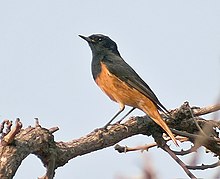Phoenicurus
| Phoenicurus | |
|---|---|

| |
| Black redstart (Phoenicurus ochruros) | |
| Scientific classification | |
| Kingdom: | Animalia |
| Phylum: | Chordata |
| Class: | Aves |
| Order: | Passeriformes |
| Family: | Muscicapidae |
| Subfamily: | Saxicolinae |
| Genus: | Phoenicurus T. Forster, 1817 |
Phoenicurus is a genus of passerine birds in the Old World flycatcher family Muscicapidae, native to Europe, Asia and Africa. They are named redstarts from their orange-red tails ('start' is an old name for a tail). They are small insectivores, the males mostly brightly coloured in various combinations of red, blue, white, and black, the females light brown with a red tail.[1] A molecular phylogenetic study published in 2010 led to a reorganization of the Old World flycatchers family in which the two species in Rhyacornis and the single species in Chaimarrornis were merged into Phoenicurus.[2][3]
The genus Phoenicurus was introduced by the English naturalist Thomas Forster in 1817.[4][5] The name Phoenicurus is from Ancient Greek φοινιξ (phoinix), "(Phoenician) crimson/purple" (see also Tyrian purple), and ουροσ (-ouros) -"tailed".[6]
The genus contains the following species:[3]
- Przevalski's redstart (Phoenicurus alaschanicus)
- Eversmann's redstart (Phoenicurus erythronotus)
- Blue-capped redstart (Phoenicurus coeruleocephala)
- Black redstart (Phoenicurus ochruros)
- Common redstart (Phoenicurus phoenicurus)
- Hodgson's redstart (Phoenicurus hodgsoni)
- White-throated redstart (Phoenicurus schisticeps)
- Daurian redstart (Phoenicurus auroreus)
- Moussier's redstart (Phoenicurus moussieri)
- Güldenstädt's redstart (Phoenicurus erythrogastrus)
- Blue-fronted redstart (Phoenicurus frontalis)
- Plumbeous water redstart (Phoenicurus fuliginosus) (previously in the genus Rhyacornis)
- Luzon water redstart (Phoenicurus bicolor) (previously in the genus Rhyacornis)
- White-capped redstart (Phoenicurus leucocephalus) (previously in the monotypic genus Chaimarrornis)
Fossil record[]
- †Phoenicurus erikai (Pliocene of Csarnota, Hungary).[7]
- †Phoenicurus baranensis (Pliocene of Beremend, Hungary).[7]
References[]
- ^ Hoyo, J. del, et al., eds. (2005). Handbook of the Birds of the World, vol. 10. Barcelona: Lynx Edicions. pp. 768–773. ISBN 84-87334-72-5.CS1 maint: extra text: authors list (link)
- ^ Sangster, G.; Alström, P.; Forsmark, E.; Olsson, U. (2010). "Multi-locus phylogenetic analysis of Old World chats and flycatchers reveals extensive paraphyly at family, subfamily and genus level (Aves: Muscicapidae)". Molecular Phylogenetics and Evolution. 57 (1): 380–392. doi:10.1016/j.ympev.2010.07.008. PMID 20656044.
- ^ a b Gill, Frank; Donsker, David (eds.). "Chats, Old World flycatchers". World Bird List Version 6.2. International Ornithologists' Union. Retrieved 20 May 2016.
- ^ Forster, Thomas (1817). A Synoptical Catalogue of British Birds. London: Nichols, Son, and Bentley. p. 53.
- ^ Mayr, Ernst; Paynter, Raymond A. Jr, eds. (1960). Check-list of Birds of the World. Volume 10. Cambridge, Massachusetts: Museum of Comparative Zoology. p. 74.
|volume=has extra text (help) - ^ Jobling, James A. (2010). The Helm Dictionary of Scientific Bird Names. London: Christopher Helm. p. 304. ISBN 978-1-4081-2501-4..
- ^ a b Kessler, E. (2013). "Neogene songbirds (Aves, Passeriformes) from Hungary". Hantkeniana. 8: 37–149.
Further reading[]
- Voelker, G.; Semenov, G.; Fadeev, I.V.; Blick, A.; Drovetski, S.V. (2015). "The biogeographic history of Phoenicurus redstarts reveals an allopatric mode of speciation and an out-of-Himalayas colonization pattern". Systematics and Biodiversity. 13 (3): 296–305. doi:10.1080/14772000.2014.992380.
- Phoenicurus
- Bird genera
- Taxa named by Thomas Ignatius Maria Forster
- Muscicapidae stubs